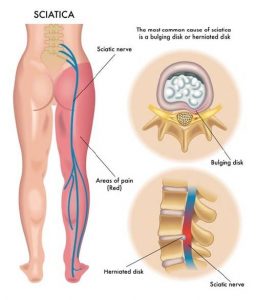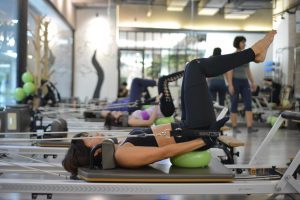Hello Everyone,
Hope you’re having a Pil-easant Week!
Recently, I’ve come across some individuals facing a health concern known as Sciatica and I want to address basic information about this condition as it is proven that Pilates is becoming a trending therapy for easing Sciatica pain.
What is Sciatica?
This is a condition that results in pain, numbness or tingling feelings in the largest nerve in our body, known as the sciatic nerve that runs in our back and legs. Our Sciatic nerve starts from our vertebrae at the lower back and hip area and travels in and out of our pelvic region to the buttocks, extends all the way down to the back of the leg, behind the knee and then to the foot. Any kind of pressure on the Sciatic nerve will cause sciatic pain, discomfort and irritation.
Causes of Sciatica include; Spinal injury, abnormal bone growths, compression of the spinal canal, swollen or tight muscles in the buttocks…etc. It’s difficult to identify a specific cause of the condition however, people who are in the following positions have higher risks of Sciatica pain:
 Obesity
Obesity- Sitting for a long time
- Diabetes
- Occupations that involve a lot of twisting or picking up heavy items
- Age related spinal changes
- Poor lifestyle
- Lack of Core Strength
Sciatic treatment includes medication, therapy, surgery or lifestyle changes and depends on the severity of the condition. If the condition is severe, you may need surgery, however, I’m a big believer of making that the last resort.
How Can Pilates Help?
The objective of any sciatica treatment is to reduce pain and increase mobility; both of which can be addressed through Pilates. No doubt, this is most likely to be combined with medication to reduce the irritation and inflammation of the sciatic nerve.
It’s always important to ensure that you are supervised by a Trained and Professional Instructor as you want to be careful not to irritate or overstretch the sciatic nerve further since it’s already in a bad state. Pilates exercises (under proper supervision) reduces pressure on the sciatic nerve and increases the space around the nerve. Through repeated exercises, it helps bring back the nerve to what it used to be before the pain.
The best Pilates exercises are the ones done in a neutral spine position which is when all the 3 parts of the spine (the neck, the thoracic and the lumbar) are positioned in good alignment. Pilates also involves building strength in the abdominal as well as the back muscles which helps improve the physical strength and makes it an effective therapy for this condition.
The beauty of Pilates is that it can be tailored to the individual’s physical and fitness position using a variety of apparatuses. Moreover, Pilates targets the deep tissue muscles that support the sciatic nerve. Through regular practice, individuals will be able to see a natural progression to stronger movements, thereby, reducing tension and pain relief.
According to a study that was done on a 27-year old Sciatica patient, after 30 sessions of regular Pilates, the individual’s posture changed and her pain became rare compared to the pain she used to face which was rated a 6 from a scale of 1-10. Moreover, another study of 5 elderly women concluded an improvement in pain and quality of life after completing regular Pilates sessions.
It’s always best to consult with the doctor and get professional Pilates supervision for this condition. However, why not build your body strength through Pilates in the first place to avoid or reduce the impact of such conditions.
Join our Pilates Certifications to understand the method and the benefits and become a certified teacher at the same time.
Click here for more info: https://sanamotion.com/swisspilates/
With Love,
Patricia

